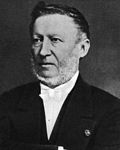Partial general elections were held in Belgium on 13 June 1876.[1][2] In the elections for the Chamber of Representatives the result was a victory for the Catholic Party, which won 67 of the 124 seats.[2] Voter turnout was 67.5%, although only 63,278 people were eligible to vote.
| ||||||||||||||||||||||||||||||||||
63 of the 124 seats in the Chamber of Representatives 63 seats needed for a majority | ||||||||||||||||||||||||||||||||||
|---|---|---|---|---|---|---|---|---|---|---|---|---|---|---|---|---|---|---|---|---|---|---|---|---|---|---|---|---|---|---|---|---|---|---|
| ||||||||||||||||||||||||||||||||||
| ||||||||||||||||||||||||||||||||||
Under the alternating system, elections were only held in five out of the nine provinces: Antwerp, Brabant, Luxembourg, Namur and West Flanders.
Additionally, special elections were held:
- Simultaneously with the partial general elections to elect a representative for the arrondissement of Liège
- On 7 August 1876 to elect a representative for the arrondissement of Leuven following the death of Edouard Wouters on 13 July 1876
- On 7 September 1876 to elect a representative for the arrondissement of Virton replacing Albert de Briey
Results
editChamber of Representatives
edit| Party | Votes | % | Seats | |||||
|---|---|---|---|---|---|---|---|---|
| Won | Total | +/– | ||||||
| Catholic Party | 22,952 | 53.70 | 42 | 67 | –1 | |||
| Liberal Party | 19,788 | 46.30 | 21 | 57 | +1 | |||
| Total | 42,740 | 100.00 | 63 | 124 | 0 | |||
| Total votes | 42,740 | – | ||||||
| Registered voters/turnout | 63,278 | 67.54 | ||||||
| Source: Mackie & Rose,[3] Sternberger et al. | ||||||||

